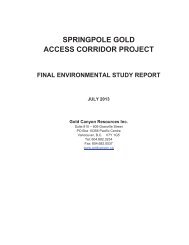Malawi NI 43-101 - December 2011 - Gold Canyon Resources Inc.
Malawi NI 43-101 - December 2011 - Gold Canyon Resources Inc.
Malawi NI 43-101 - December 2011 - Gold Canyon Resources Inc.
- No tags were found...
Create successful ePaper yourself
Turn your PDF publications into a flip-book with our unique Google optimized e-Paper software.
42procedure PUL-21 (pulverized to 85% -75 microns). Samples were analyzed fortotal REE and other trace elements by procedure ME-MS81 and for majorelements by method MS-IP06. Samples of 0.2 g sample were fused with 0.9 glithium metaborate at 1,000˚ C, the glass was dissolved in 100 ml 4% HNO 3 /2%HCl and analyzed by ICP-MS for method ME-MS81 and by ICP-AES for methodME-ICP06. The REE results are reported in Table 10.Soil samples were analyzed for leachable REE by ALS-Chemex as follows.Soils were first air dried using procedure DRY-23 and leached by procedure ME-MS23 (a selective leach of weakly bound ions by sodium cyanide with chelatingagents ammonium chloride, citric acid and EDTA, with the leachant buffered atpH 8.5, analysis by ICP-MS) and by procedure ME-MS04 ( a weak leach with 1.0g sample mixed with 25 ml of ammonium acetate solution in acetic acid, shakenfor 2 hours, the leachant separated by centrifuge and decantation, analysis byICP-MS and by ICP-AES). The leached residues from ME-MS04 were alsopulverized (PUL-21) and analyzed for REE by method ME-MS81 and ME-ICP06..Results by method ME-MS04 for the samples listed in Table 8 are shownin Table 10 (total REE) and in Table 11, (leachable REE).1 Resampling and analysis of samples taken by J. Ishikawa On 21 Augustof <strong>2011</strong> the author visited J. Ishikawa in his office at the Geological Survey of<strong>Malawi</strong> in Zomba and was given sub-samples of 3 of his original samples forcheck analyses both of total REE and leachable REE. These results are reportedin Table 9 along with the original analyses of these samples and analyses byMINDECO of the same samples.Samples CHA-4, CHA-6 and CHA-8 have now been analyzed for leachableREE by 3 laboratories and these results are compared in Table 9 and Figure 12.The result of re-analysis of the 3 original Ishikawa samples generally confirmstheir high percentage of leachable REE, from 31 to 74% for all REE or 41 to 86%for all REE except Ce. As previously noted, ionic REE deposits generally show alower percentage of leachable Ce than other REE.It appears that method ME-MS04 gives results similar to the ammoniumsulphate leach used by Nittetsu and University of Tokyo. However, the ME-MS23






